
Berry railway station is a heritage-listed single-platform intercity train station located in Berry, New South Wales, Australia, on the South Coast railway line. The station serves NSW TrainLink diesel multiple unit trains travelling south to Bomaderry and north to Kiama. Early morning and late night services to the station are provided by train replacement bus services. In the past, the station precinct also catered to freight trains carrying cattle and dairy products.
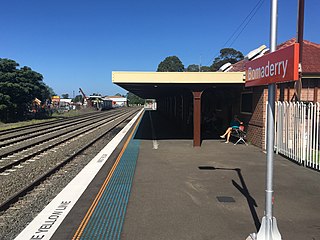
Bomaderry railway station is a heritage-listed single-platform intercity train station located in Bomaderry, New South Wales, Australia, on the South Coast railway line. The station serves NSW TrainLink diesel multiple unit trains to Kiama. Early morning and late night services to the station are provided by train replacement bus services. A siding near the station is used by freight trains operated by the Manildra Group.

Emu Plains railway station is a heritage-listed railway station located on the Main Western line in the western Sydney suburb of Emu Plains in the City of Penrith local government area of New South Wales, Australia. It was designed by the New South Wales Government Railways and built from 1884 to 1907 by M. Reed, et al. It is also known as Emu Plains Railway Station group. The property was added to the New South Wales State Heritage Register on 2 April 1999. The station is served by Sydney Trains T1 Western line services and NSW TrainLink Blue Mountains line services.

Lawson railway station is a heritage-listed railway station located on the Main Western line in Lawson in the City of Blue Mountains local government area of New South Wales, Australia. It is also known as Lawson Railway Station Group and Christmas Swamp; Blue Mountain. The property was added to the New South Wales State Heritage Register on 2 April 1999. The station opened on 11 July 1867 as Blue Mountain, being renamed Lawson on 21 April 1879. A passing loop exists north of Platform 1. As part of widening work to the Great Western Highway, a siding south of Platform 2 was removed and a new submerged siding constructed west of the station.
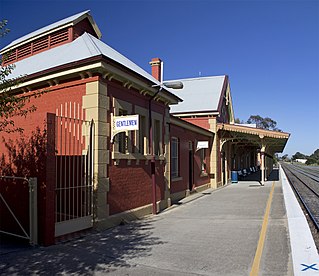
Queanbeyan railway station is a heritage-listed railway station located on the Bombala line in New South Wales, Australia. It serves the town of Queanbeyan.

Orange railway station is a heritage-listed former railway bridge and now railway station located on the Main Western line on Peisley Street, Orange in the City of Orange local government area of New South Wales, Australia. It was built from 1877 to 1950. It is also known as Orange Railway Station and yard group. The property was added to the New South Wales State Heritage Register on 2 April 1999.

Carlton House is a heritage-listed boarding house at 3 Mill Street, Toowoomba, Toowoomba Region, Queensland, Australia. It was built from c. 1875 to 1900s. It was added to the Queensland Heritage Register on 31 October 1994.

Defiance Flour Mill is a heritage-listed mill at 269–291 Ruthven Street, Toowoomba, Toowoomba Region, Queensland, Australia. It was designed by Toowoomba architect William Hodgen and built in 1911 by WT Smith. It was added to the Queensland Heritage Register on 26 February 2002.
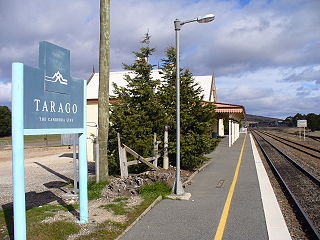
Tarago railway station is a heritage-listed railway station located on the Bombala line in New South Wales, Australia. It serves the town of Tarago. It was built in 1884 by G. & C. Horn. It was added to the New South Wales State Heritage Register on 2 April 1999.

Bungendore railway station is a heritage-listed railway station located on the Bombala line in New South Wales, Australia. It serves the town of Bungendore. The design of the station has been attributed to John Whitton. It was built in 1884-85 by contractor J. Jordan. It was added to the New South Wales State Heritage Register on 2 April 1999.

Ormiston House Estate is a heritage-listed plantation at Wellington Street, Ormiston, City of Redland, Queensland, Australia. It was built from c. 1858 to c. 1865. It was added to the Queensland Heritage Register on 21 October 1992.

The Corowa Flour Mill is a heritage-listed former flour mill and now tourist attraction at Steel Street, Corowa, Federation Council, New South Wales, Australia. It is also known as the Corowa Flour Mill and site. It was added to the New South Wales State Heritage Register on 2 April 1999.
The McCrossins Mill is a heritage-listed former mill and store and now museum at Salisbury Street, Uralla, Uralla Shire, New South Wales, Australia. It was designed by John McCrossin and built by Unknown. The property is owned by Uralla Historical Society Inc. It was added to the New South Wales State Heritage Register on 2 April 1999.

Lansdowne Park is a heritage-listed homestead at Bungonia Road, Goulburn, Goulburn Mulwaree Council, New South Wales, Australia. It was built from 1822 to 1825. It is also known as Lansdowne. It was added to the New South Wales State Heritage Register on 2 April 1999.
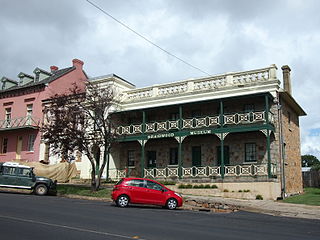
Braidwood District Historical Society Museum is a heritage-listed former hotel and Oddfellows Hall and now museum at Wallace Street, Braidwood, Queanbeyan-Palerang Region, New South Wales, Australia. The property is owned by Braidwood Historical Society. It was added to the New South Wales State Heritage Register on 2 April 1999.

The Mill Complex is a heritage-listed historic site at Wallace Street, Braidwood, Queanbeyan-Palerang Region, New South Wales, Australia. It was formerly known as the Mill Centre. It was added to the New South Wales State Heritage Register on 2 April 1999.

Ildemere is a heritage-listed residence at 11–11a Bay View Street, McMahons Point, North Sydney Council, New South Wales, Australia. It was built from 1879 to 1888. It was added to the New South Wales State Heritage Register on 2 April 1999.
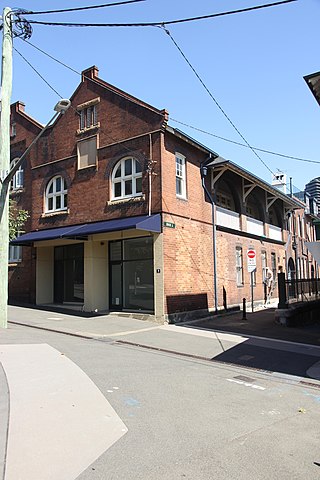
9 Argyle Place is a heritage-listed residence and commercial building at 9 Argyle Place, Millers Point, City of Sydney, New South Wales, Australia. It was built in 1910. It was added to the New South Wales State Heritage Register on 6 June 2003.

28 Kent Street, Millers Point is a heritage-listed former retail building and now residence located at 28 Kent Street, in the inner city Sydney suburb of Millers Point in the City of Sydney local government area of New South Wales, Australia. The property was added to the New South Wales State Heritage Register on 2 April 1999.

St Stephen's Presbyterian Church and Manse, also known as Queanbeyan Presbyterian Church, is a heritage-listed Presbyterian church and manse at 2 Morisset Street, Queanbeyan, New South Wales, Australia. It was designed by Alberto Dias Soares (church) and James Barnet (manse) and built from 1872 to 1883 by Thomas Priest (stonemason), Thomas Jordan (carpenter), John Kealman (carpenter). The property is owned by Presbyterian Church of NSW Property Trust. It was added to the New South Wales State Heritage Register on 24 May 2019.





















